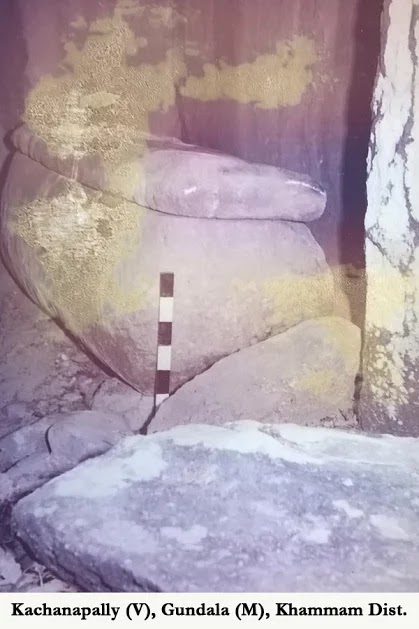C R Gowri Shanker
Deccan Chronicle
January 29, 2017
Skeletons were exhumed, buried again in 1000 BC.
Archaeologists examine a dolmen at Dameravai in Tadwai mandal of Jaishankar Bhupalapally district.
“Chamber tombs are secondary burial chambers. After death, when the flesh is gone, the skeleton and its remains are buried in chamber tombs. They date back to 1000 BC and 2nd century AD,” said Mr S.S. Rangacharyulu, archaeology consultant and former deputy director of the archaeology and museums department. Mr Rangacharyulu studied some of the chamber tombs in detail, backed by department director N.R. Visalatchy.
After rock art, megalithic burials are the most important monuments in Telangana state and are found in hundreds of villages. Chamber tombs are built on hillocks and also referred to as cromlechs and dolmens.
They are constructed with dressed slabs and look like a chamber with four or more orthostats — slabs on three sides with an opening on one side and a huge rectangular capstone. Capstones are quite heavy, some of them are 4 metres by 4 metres and 40 to 50-cm thick. The entrance to most dolmens is at the centre.
“It seems that most were family burials. There is a facility for re-use. There are one ore more stone sarcophagi inside the structure. Since these are built with stones, mostly above the ground level on hillocks, they are known as chamber tombs,” Mr Rangacharyulu said.
Among chamber tombs, one in Galaba (Galaba-gutta) and Kachanapalle (Peddhaparupugutta) in this district are rare and were not studied.
“We found graffiti marks, cruciforms and anthropomorphic figures. There are more than 300 chamber tombs on this hillock. The site is important since cruciforms depicting male and female breasts, anthropomorphic figures are lying in front of the chamber tombs. These figures, which are lying in front of the chamber tombs, indicate that originally they were in a standing position,” he said.
“Inside some chambers, stone sarcophagi are located with graffiti marks such as arrow and trident marks like ‘ma’ in Brahmi script of 2nd century BC. In one chamber tomb, six sarcophagi were found which indicates that it was a family burial,” he said.
In Kachanapalle, hundreds of chamber tombs are scattered 8 km from the village on the hillocks locally known as Peddhaparupugutta and Nandigutta. Almost all the burials consist of stone sarcophagi and were provided with lids.
“The erection of huge chamber tombs with dressed stones and carvings of sculptures representing the human form indicate that the megalithic community were culturally advanced and they had sophisticated metal implements and knowledge of geometry to cut huge stones to the required sizes,” said Mr Rangacharyulu. In Aihole and Mottur in north Karnataka, cruciforms were also found, but they were small and crude.
Not linked to Christianity
Archaeologist D.H. Gordon in his book “Prehistoric background of Indian Culture” says scholar J. Mulheran had found crosses (cruciforms) close to the stone burial cysts at Katapur and Mallur villages in Warangal. He ascribed these crosses to Christianity and said that they are not later than 7th Century AD, as pre- or non-Christian crosses were symbols unknown in India.
There was also the view that the megalithic builders were from the Mediterranean region and Western Europe and the custom of erecting cruciforms or anthropomorphic figures might have come with them before the 1st and 2nd century BC. As no other artefacts was reported from these burials, historians say it is very difficult to prove this theory.
Erection of cruciforms and anthropomorphic figures carved with and without breasts, differentiating male and female figures, clearly indicates the original intention of the carver to depict human representation. Historians assert these chamber tombs have nothing to do with the Christianity.








No comments:
Post a Comment